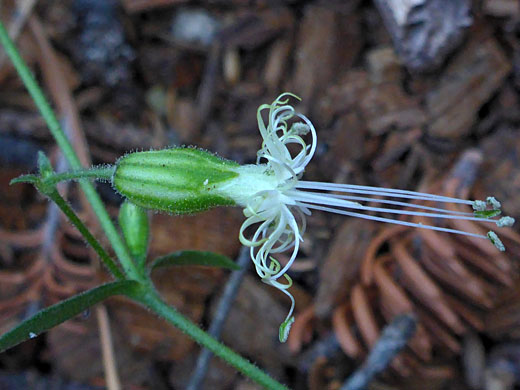Common name:
Lemmon's catchfly
Family:
Scientific name:
Silene lemmonii
Main flower color:
Range:
California and far southwest Oregon
Height:
Up to 18 inches
Habitat:
Oak and coniferous woodland, from 2,800 to 9,200 feet
Leaves:
Opposite, oblanceolate, up to 1.5 inches long, short hairy
Season:
May to September
Stems of silene lemmonii are short hairy at the base, becoming glandular towards the tip. Leaves grow mainly around the base, where they are up to 1.5 inches long; stem leaves are in widely-separated, opposite pairs; they are shorter, and narrower. Plants often have a few short, non-flowering branches at the base.
The flowers are pendent, single or in pairs, from the upper few leaf nodes. The barrel-shaped calyx, around a third of an inch long, has ten darker green ridges, and a covering of glandular hairs; it is shallowly divided into five triangular lobes. The corolla, white to pale pink or pale green, is deeply divided into five lobes, each further divided into four narrow, linear segments, similar in length to the ten exserted stamens. Anthers are green, light to dark. The three styles are also exserted, further than the stamens.
The flowers are pendent, single or in pairs, from the upper few leaf nodes. The barrel-shaped calyx, around a third of an inch long, has ten darker green ridges, and a covering of glandular hairs; it is shallowly divided into five triangular lobes. The corolla, white to pale pink or pale green, is deeply divided into five lobes, each further divided into four narrow, linear segments, similar in length to the ten exserted stamens. Anthers are green, light to dark. The three styles are also exserted, further than the stamens.
All Contents © Copyright The American Southwest | Comments and Questions | Contribute | Site Map





